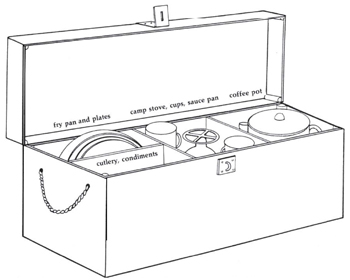I’ve always loved small boats: day sailors, trailer sailors, runabouts, and skiffs. In many ways they give the most joy for the limited time most of us can spend on the water. While not cruisers in the usual sense of the term, it’s often pleasant to spend a night or weekend aboard a small boat, especially if you are young, flexible and unarthritic. A couple of sleeping bags and air mattresses, a tent over the cockpit, and a galley add up to happiness and freedom for the young and young at heart.

350
It’s that last item on my list-the-galley-that I want to look at this month. On an open boat there’s no place for a permanent galley. Even with a cuddy on a trailer sailor, a permanent galley is seldom an effective use of space. Hence, the portable galley which can be stored away or even left at home when not in use is the answer for the smaller boat.
The drawing shows one idea for a portable galley. As you can see, it holds a gas camping fry pan, and sauce pans with removable handles, a real coffee pot (an imperative for my wife and me), plates, mugs, cutlery, etc. Anyone planning a portable galley will have to work out his own dimensions based on the sizes and complexity of the outfit chosen. Use the drawing as a starting point for your own design.
The construction I suggest goes as follows. For the main structural panels of sides, top, and bottom, use 3/16” or ¼” waterproof plywood. For backing the joints use 3/8” or quarter round, as shown in the drawing. Brass brads and epoxy adhesive would be a good combination for sticking the whole thing together. If, however, you plan to varnish the unit, you might wish to try urea resin glue. This is the stuff you buy in hardware stores as “plastic resin glue”. It comes as a powder which you mix with water to form a thick syrup, and while not boil proof, it’s effectively water resistant and perfectly satisfactory for jobs like this where the finished product won’t be submerged for long periods of time.
Urea glue is cheap: and best of all for something you intend for varnishing, it cleans up with water if you catch it before it sets up.
I’d suggest two or three short brass flat hinges for the cover, and a trunk latch or turn button hasp to keep the box closed.
Rope handles are shown. They can be easily installed by drilling appropriately-sized holes in the box sides, threading the rope through and tying stopper knots on the inside. You might even consider lettering the boat’s name on the top of the box.
No one besides a genius or a masochist would try and cook multi-course meals with a portable galley, but on a small boat in a quiet cove, the smell of bacon and eggs or steak and onions should be enough to make you forget fancier meals. And think of the Bavarian chocolate coffee gently perking. I’m off to eat!








































